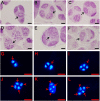Triploid cultivars of Cymbidium act as a bridge in the formation of polyploid plants
- PMID: 36684754
- PMCID: PMC9853991
- DOI: 10.3389/fpls.2022.1029915
Triploid cultivars of Cymbidium act as a bridge in the formation of polyploid plants
Abstract
Triploid is considered a reproductive barrier and also a bridge in the formation of polyploids. However, few reports are available in Cymbidium. In this study, diploid 'Xiaofeng', sexual triploid 'Yuchan' and 'Huanghe' of Cymbidium were used to evaluate hybridization compatibility of the triploids. Results showed that the sexual triploids were fertile whether they were used as male or female parents. 'Yuchan' produced male gametes of 1x, 1x~2x, 2x, 2x~3x, and 3x at frequencies of 8.89%, 77.78%, 6.67%, 3.33%, and 3.33%, respectively; while 'Huanghe' produced 3.33% 1x, 80.00% 1x~2x, 8.89% 2x, 5.56% 2x~3x, and 2.22% 3x male gametes. The cross of 'Xiaofeng' with 'Yuchan' produced progenies with a wide range of ploidy levels, including one diploid, 34 2×~3× aneuploids, 12 triploids, and one tetraploid, indicating that male gametes produced by sexual triploid were fertile and could be transmitted and fused with egg cells. On the other hand, 10 progenies obtained from the cross of 'Yuchan' × 'Xiaofeng' were all aneuploids. The cross of 'Yuchan' with 'Huanghe' produced 40 progenies including three 2×~3× aneuploids, nine 3×~4× aneuploids, 21 tetraploids, six 4×~5× aneuploids, and one pentaploid, suggesting that 2x gametes, instead of the unreduced ones played a more important role in the formation of tetraploids. The survival rates of the hybrids were all above 80.00%, with the tetraploids at 96.67%. Cytological analysis revealed that during meiosis of sexual polyploids, two chromosome sets of the 2n gamete were inclined to enter into the same daughter cell, resulting in the production of 2x gametes. Our results indicate that the triploid cymbidiums are not reproductive barrier but serve as a bridge in the formation of polyploid plants.
Keywords: Cymbidium; cross compatibility; polyploidy; triploid bridge; unreduced gamete.
Copyright © 2022 Li, Su, Zu, Xie, Wei, Guo, Chen, Zeng and Zhang.
Conflict of interest statement
The authors declare that the research was conducted in the absence of any commercial or financial relationships that could be construed as a potential conflict of interest.
Figures






Similar articles
-
Fecundity and offspring ploidy in matings among diploid, triploid and tetraploid Chamerion angustifolium (Onagraceae): consequences for tetraploid establishment.Heredity (Edinb). 2001 Nov;87(Pt 5):573-82. doi: 10.1046/j.1365-2540.2001.00955.x. Heredity (Edinb). 2001. PMID: 11869348
-
Microsatellite and flow cytometry analysis to help understand the origin of Dioscorea alata polyploids.Ann Bot. 2013 Sep;112(5):811-9. doi: 10.1093/aob/mct145. Epub 2013 Aug 1. Ann Bot. 2013. PMID: 23912697 Free PMC article.
-
Unreduced Male Gamete Formation in Cymbidium and Its Use for Developing Sexual Polyploid Cultivars.Front Plant Sci. 2020 May 15;11:558. doi: 10.3389/fpls.2020.00558. eCollection 2020. Front Plant Sci. 2020. PMID: 32499802 Free PMC article.
-
Distant hybridization leads to different ploidy fishes.Sci China Life Sci. 2010 Apr;53(4):416-25. doi: 10.1007/s11427-010-0057-9. Epub 2010 May 7. Sci China Life Sci. 2010. PMID: 20596907 Review.
-
Exploiting Unreduced Gametes for Improving Ornamental Plants.Front Plant Sci. 2022 Jun 6;13:883470. doi: 10.3389/fpls.2022.883470. eCollection 2022. Front Plant Sci. 2022. PMID: 35734261 Free PMC article. Review.
Cited by
-
Naturally Occurring Triploidy in Cannabis.Plants (Basel). 2023 Nov 22;12(23):3927. doi: 10.3390/plants12233927. Plants (Basel). 2023. PMID: 38068564 Free PMC article.
-
Decoding hybridization barriers: the molecular and genetic orchestration of the triploid block in Arabidopsis thaliana.BMC Plant Biol. 2025 Jul 15;25(1):913. doi: 10.1186/s12870-025-06844-9. BMC Plant Biol. 2025. PMID: 40665226 Free PMC article. Review.
-
Varied chromosome distribution behaviours during meiosis in triploid Chinese chives contribute to the formation of viable pollen.Chromosome Res. 2024 Dec 2;32(4):15. doi: 10.1007/s10577-024-09759-7. Chromosome Res. 2024. PMID: 39617814
-
Interspecific transfer of genetic information through polyploid bridges.Proc Natl Acad Sci U S A. 2024 May 21;121(21):e2400018121. doi: 10.1073/pnas.2400018121. Epub 2024 May 15. Proc Natl Acad Sci U S A. 2024. PMID: 38748576 Free PMC article.
References
-
- Bergstrom I. (1940). On the progeny of diploid × triploid Populus tremula with special reference to the occurrence of tetraploidy. Hereditas 26, 191–201. doi: 10.1111/j.1601-5223.1940.tb03231.x - DOI
-
- Bhatti S. K., Thakur M. (2022). An overview on orchids and their interaction with endophytes. Bot. Rev. doi: 10.1007/s12229-022-09275-5 - DOI
LinkOut - more resources
Full Text Sources

